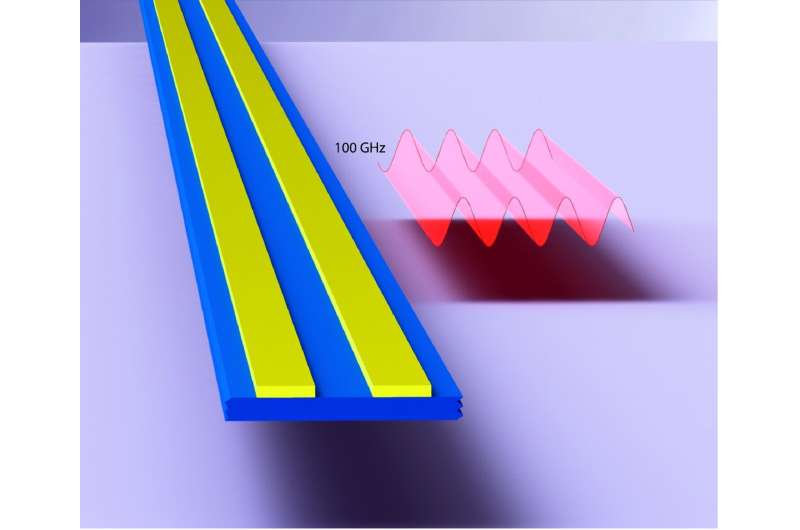Electromechanical resonators operating at sub-terahertz frequencies

To further advance communication systems, increasing both their speed and efficiency, electronics engineers will need to create new and highly performing components, including electromechanical resonators. Electromechanical resonators are essential components of communications systems that can be used to generate powerful waves of specific frequencies or selectively broadcast communication signals at specific frequencies.
To speed up communications further and pave the way for the next generation of wireless networks (6G), new resonators should ideally operate at sub-terahertz frequencies (i.e., at frequencies above 100GHz). In a recent paper published in Nature Electronics, a team of researchers led by Prof. Hong Tang at Yale University introduced new electromechanical resonators that could operate at these high frequencies.
“Our research emphasizes increasing the operating frequencies of electromechanical resonators to exceed 100 GHz,” Jiacheng Xie, the lead author who carried out the study, told Tech Xplore. “The foundation of modern communication systems relies on the continuous progress in resonator technologies, as higher-frequency oscillators lead to faster communication speeds. With the ongoing worldwide implementation of 5G communication technologies, there is a growing demand for higher-frequency resonators to support emerging technological advancements.”
The microelectromechanical resonators created by Xie and his colleagues are comprised of a millimeter-wave dual rail resonator placed on top of a suspended lithium niobate beam. To suspend this beam inside their device, the researchers chemically etched away the silicon dioxide underneath it, which also minimized the loss of acoustic waves into the surrounding space.
“To effectively stimulate and measure the sub-terahertz mechanical resonances, we employ a millimeter-wave dual rail resonator that aids the electromechanical transduction by providing improved on-chip impedance matching to the mechanical modes,” Xie explained. “An intuitive analogy can be drawn to the way a violin generates powerful sounds audible to listeners in large concert halls without the need for an amplifier. Although the strings determine the instrument’s pitch, the violin’s body functions as a broadband resonator that projects the sound, similar to how a dual-rail resonator broadcasts the sub-terahertz resonances for detection.”
Notably, the team’s resonator was created using commercially available thin films of lithium niobate, which were patterned using technologies that are widely employed for the fabrication of semiconductors. This could greatly facilitate its large-scale fabrication and implementation in the future.
Xie and his colleagues were the first to create electromechanical resonators that operate at frequencies beyond 100 GHz. Their work could thus have important implications for the development of 6G communication systems.
“This breakthrough has the potential to contribute to the evolution of future communication systems, as the Federal Communications Commission (FCC) has created experimental licenses for the use of frequencies between 95 GHz and 3 THz,” Xie said. “Furthermore, from a quantum science and technology perspective, it is beneficial to bring mechanical quantum systems out of million-dollar dilution refrigerators. Sub-THz resonators, with ultrahigh resonant frequencies, are significantly more resilient to thermal fluctuations than GHz resonators, and therefore can reach the quantum ground state at much more accessible Kelvin temperatures.”
The recent work by Xie and his colleagues could soon inform the development of other electromechanical resonators that operate at sub-terahertz frequencies. Meanwhile, the researchers plan to advance their devices further, while also trying to create other highly performing components for future communication systems.
“We will now continue our efforts to develop electromechanical resonators with even higher frequencies,” Tang added. “Additionally, our focus will be on creating applications leveraging our existing technologies.”
More information:
Jiacheng Xie et al, Sub-terahertz electromechanics, Nature Electronics (2023). DOI: 10.1038/s41928-023-00942-y.
© 2023 Science X Network
Citation:
Electromechanical resonators operating at sub-terahertz frequencies (2023, April 15)
retrieved 15 April 2023
from https://techxplore.com/news/2023-04-electromechanical-resonators-sub-terahertz-frequencies.html
This document is subject to copyright. Apart from any fair dealing for the purpose of private study or research, no
part may be reproduced without the written permission. The content is provided for information purposes only.
For all the latest Technology News Click Here
For the latest news and updates, follow us on Google News.

